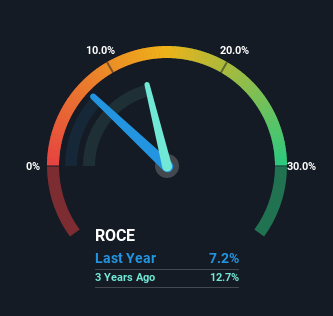There are a few key trends to look for if we want to identify the next multi-bagger. Firstly, we'll want to see a proven return on capital employed (ROCE) that is increasing, and secondly, an expanding base of capital employed. Put simply, these types of businesses are compounding machines, meaning they are continually reinvesting their earnings at ever-higher rates of return. However, after investigating Famur (WSE:FMF), we don't think it's current trends fit the mold of a multi-bagger.
What is Return On Capital Employed (ROCE)?
Just to clarify if you're unsure, ROCE is a metric for evaluating how much pre-tax income (in percentage terms) a company earns on the capital invested in its business. The formula for this calculation on Famur is:
Return on Capital Employed = Earnings Before Interest and Tax (EBIT) ÷ (Total Assets - Current Liabilities)
0.072 = zł154m ÷ (zł2.7b - zł521m) (Based on the trailing twelve months to September 2021).
Therefore, Famur has an ROCE of 7.2%. In absolute terms, that's a low return and it also under-performs the Machinery industry average of 11%.
View our latest analysis for Famur

In the above chart we have measured Famur's prior ROCE against its prior performance, but the future is arguably more important. If you're interested, you can view the analysts predictions in our free report on analyst forecasts for the company.
So How Is Famur's ROCE Trending?
In terms of Famur's historical ROCE trend, it doesn't exactly demand attention. The company has consistently earned 7.2% for the last five years, and the capital employed within the business has risen 88% in that time. This poor ROCE doesn't inspire confidence right now, and with the increase in capital employed, it's evident that the business isn't deploying the funds into high return investments.
One more thing to note, even though ROCE has remained relatively flat over the last five years, the reduction in current liabilities to 20% of total assets, is good to see from a business owner's perspective. Effectively suppliers now fund less of the business, which can lower some elements of risk.
The Key Takeaway
As we've seen above, Famur's returns on capital haven't increased but it is reinvesting in the business. And investors appear hesitant that the trends will pick up because the stock has fallen 45% in the last five years. Therefore based on the analysis done in this article, we don't think Famur has the makings of a multi-bagger.
If you'd like to know about the risks facing Famur, we've discovered 1 warning sign that you should be aware of.
While Famur isn't earning the highest return, check out this free list of companies that are earning high returns on equity with solid balance sheets.
New: Manage All Your Stock Portfolios in One Place
We've created the ultimate portfolio companion for stock investors, and it's free.
• Connect an unlimited number of Portfolios and see your total in one currency
• Be alerted to new Warning Signs or Risks via email or mobile
• Track the Fair Value of your stocks
Have feedback on this article? Concerned about the content? Get in touch with us directly. Alternatively, email editorial-team (at) simplywallst.com.
This article by Simply Wall St is general in nature. We provide commentary based on historical data and analyst forecasts only using an unbiased methodology and our articles are not intended to be financial advice. It does not constitute a recommendation to buy or sell any stock, and does not take account of your objectives, or your financial situation. We aim to bring you long-term focused analysis driven by fundamental data. Note that our analysis may not factor in the latest price-sensitive company announcements or qualitative material. Simply Wall St has no position in any stocks mentioned.
About WSE:GEA
Grenevia
Manufactures and sells machinery and equipment for mining, transport, and power industries worldwide.
Solid track record with excellent balance sheet.
Similar Companies
Market Insights
Community Narratives




